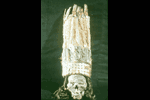|
Nazca Culture
"The culture now called Nasca is named after the Nasca
River valley of the south coast of Peru. The Nasca were
renowned for their pottery. Thousands of their ceramic
vessels survive. ... The subjects vary greatly with emphasis on
plants, animals, and composite mythological creatures, partly
human, partly animal.
Polychrome pottery is not the sole
source of Nasca's fame. Some eight-hundred miles of lines,
drawn in complex networks on the dry surface of the Nasca plain
in southwestern Peru, have long attracted world attention as
mysterious and gigantic artworks. Nasca artists traced out
about three dozen images of birds, fish, and plants on the
plain. Our illustration [see below] shows a hummingbird
with a wingspan of more than two-hundred feet. The Nasca
artists also drew geometric forms, such as trapezoids, spirals,
and straight lines. Uniformly, the Nasca Lines, as the immense
drawings are called, appear light on a dark ground. The
Nasca produced the effect by scraping aside the sun-darkened
desert pebbles to reveal the lighter layer of whitish clay and
calcite beneath. The near-rainless environment has
preserved the drawings for centuries, but modern highways and
off-road vehicles have damaged many of the Nasca lines."
- Gardner's
Art Through The Ages,
11th edition, Vol. I, p. 404
|

| Hummingbird (Nazca Plains - Peru)

Monkey (Nazca Plains - Peru)
"Given the huge size
and bewildering intricacy of the patterns, speculation
continues as to the source, construction, and meaning of the
Nasca lines. Although they are best seen from the air,
they are also visible from the Andean foothills and the
great coastal dunes. The lines were constructed quite
easily from available materials and with some rudimentary
geometry. A small group of workers have made modern
reproductions of them with relative ease. The lines
seem to be paths laid out using simple stone-and-string
methods. Some lead in traceable directions across the
deserts of the Nasca River drainage, while others are
punctuated by many shrine-like nodes, like the knots on a
cord. The lines converge at central places usually
situated close to water sources and seem to be associated
with water supply and irrigation. They may have marked
pilgrimage routes for those who journeyed to local or
regional shrines on foot. Although astronomical
functions have been proposed for the lines, this theory has
not been convincingly demonstrated. Altogether, the
vast arrangement of the Nasca Lines is a system - not a
meaningless maze but a traversable map that plotted out the
whole terrain of the Nasca material and spiritual concerns.
Remarkably, until quite recently similar ritual pathways
were made and used in association with shrines in highland
Bolivia, demonstrating the tenacity of the Andean indigenous
belief systems."
- Gardner's
Art Through The Ages,
11th edition, Vol. I, p. 404

Mummified Scull (Peru)

|
|
|
|